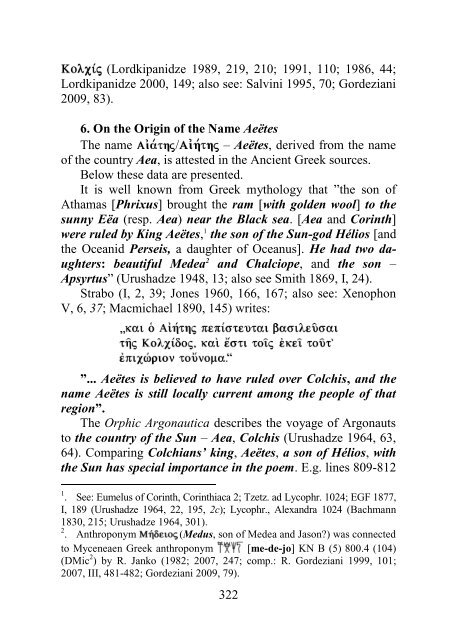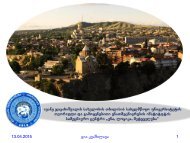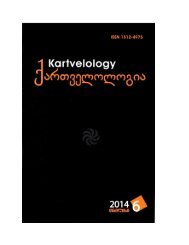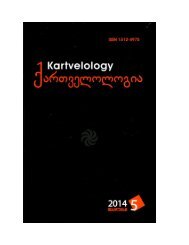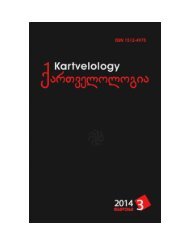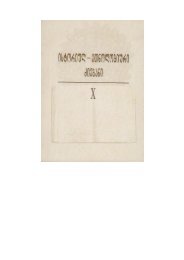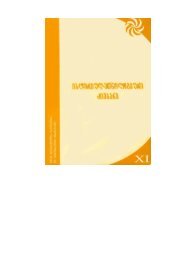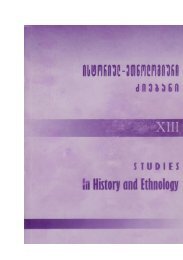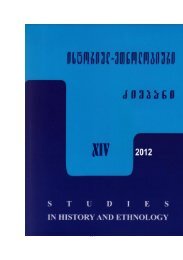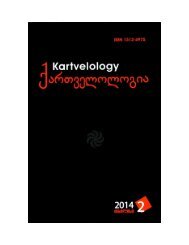Kvashilava, Gia, 2010. On Reading Pictorial Signs of the Phaistos Disk and Related Scripts (2). Rosette (in Georgian and English)
This study concerns the graphic character, symbolic meanings, typological parallels, commentaries and reading of the Phaistos Disk pictorial sign PHD38.
This study concerns the graphic character, symbolic meanings, typological parallels, commentaries and reading of the Phaistos Disk pictorial sign PHD38.
Create successful ePaper yourself
Turn your PDF publications into a flip-book with our unique Google optimized e-Paper software.
(Lordkipanidze 1989, 219, 210; 1991, 110; 1986, 44;<br />
Lordkipanidze 2000, 149; also see: Salv<strong>in</strong>i 1995, 70; Gordeziani<br />
2009, 83).<br />
6. <strong>On</strong> <strong>the</strong> Orig<strong>in</strong> <strong>of</strong> <strong>the</strong> Name Aeëtes<br />
The name / – Aeëtes, derived from <strong>the</strong> name<br />
<strong>of</strong> <strong>the</strong> country Aea, is attested <strong>in</strong> <strong>the</strong> Ancient Greek sources.<br />
Below <strong>the</strong>se data are presented.<br />
It is well known from Greek mythology that ”<strong>the</strong> son <strong>of</strong><br />
Athamas [Phrixus] brought <strong>the</strong> ram [with golden wool] to <strong>the</strong><br />
sunny Eëa (resp. Aea) near <strong>the</strong> Black sea. [Aea <strong>and</strong> Cor<strong>in</strong>th]<br />
were ruled by K<strong>in</strong>g Aeëtes, 1 <strong>the</strong> son <strong>of</strong> <strong>the</strong> Sun-god Hélios [<strong>and</strong><br />
<strong>the</strong> Oceanid Perseis, a daughter <strong>of</strong> Oceanus]. He had two daughters:<br />
beautiful Medea 2 <strong>and</strong> Chalciope, <strong>and</strong> <strong>the</strong> son –<br />
Apsyrtus” (Urushadze 1948, 13; also see Smith 1869, I, 24).<br />
Strabo (I, 2, 39; Jones 1960, 166, 167; also see: Xenophon<br />
V, 6, 37; Macmichael 1890, 145) writes:<br />
”... Aeëtes is believed to have ruled over Colchis, <strong>and</strong> <strong>the</strong><br />
name Aeëtes is still locally current among <strong>the</strong> people <strong>of</strong> that<br />
region”.<br />
The Orphic Argonautica describes <strong>the</strong> voyage <strong>of</strong> Argonauts<br />
to <strong>the</strong> country <strong>of</strong> <strong>the</strong> Sun – Aea, Colchis (Urushadze 1964, 63,<br />
64). Compar<strong>in</strong>g Colchians’ k<strong>in</strong>g, Aeëtes, a son <strong>of</strong> Hélios, with<br />
<strong>the</strong> Sun has special importance <strong>in</strong> <strong>the</strong> poem. E.g. l<strong>in</strong>es 809-812<br />
1 . See: Eumelus <strong>of</strong> Cor<strong>in</strong>th, Cor<strong>in</strong>thiaca 2; Tzetz. ad Lycophr. 1024; EGF 1877,<br />
I, 189 (Urushadze 1964, 22, 195, 2c); Lycophr., Alex<strong>and</strong>ra 1024 (Bachmann<br />
1830, 215; Urushadze 1964, 301).<br />
2 . Anthroponym (Medus, son <strong>of</strong> Medea <strong>and</strong> Jason?) was connected<br />
to Myceneaen Greek anthroponym [me-de-jo] KN B (5) 800.4 (104)<br />
(DMic 2 ) by R. Janko (1982; 2007, 247; comp.: R. Gordeziani 1999, 101;<br />
2007, III, 481-482; Gordeziani 2009, 79).<br />
322


